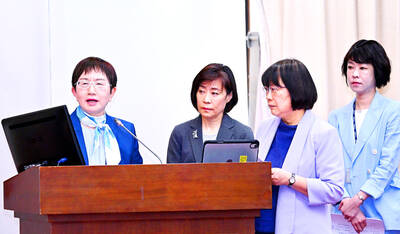The nation’s exports fell 9.7 percent from a month earlier to US$27.88 billion last month because of weaker seasonal demand for Taiwanese electronics and the shutdown of several plants at the sixth naphtha cracker complex, the Ministry of Finance said yesterday.
However, exports still grew 10.8 percent last month from a year earlier, with exports surging 16.9 percent year-on-year to US$154.14 billion in the first six months, the strongest level ever, the ministry’s data showed.
“The continuing strong momentum of Asian economies, and the robust demand from US and European countries for high-tech products made by local companies, drove up Taiwan’s exports in the first half of the year,” Lin Lee-jen (林麗貞), director of the statistics department, said at a media briefing.
Robust demand for smartphones and tablets made by Taiwanese companies helped boost exports in information and communications technology products to US$3.91 billion in the first six months, up 66.3 percent year-on-year, the highest growth among 10 sectors, Lin said.
Outbound shipments to China and Hong Kong, the US, Japan, Europe and ASEAN all hit a record high in the first half of the year, Lin said, adding that exports to ASEAN accounted for 16.4 percent of overall exports during the period, the highest level in history.
Looking forward to the second half of the year, rising uncertainties about the global economy — including fiscal tightening measures in emerging markets and the eurozone’s debt crisis — may slow the growth of exports, Lin said.
“However, the ministry remains optimistic that full-year exports will reach the government’s goal of US$310 billion, because the global economy is still in a recovery phase,” she said.
Imports surged 20.3 percent from a year earlier to US$144.07 billion in the first six months, also the highest on record, with imports of capital goods, consumer goods and agricultural and industrial raw materials all reaching a historic high, the ministry said.
Because imports grew faster than exports, the nation’s trade surplus fell 17.1 percent year-on-year to US$10.08 billion in the second half of the year, data showed.
“However, this may not hurt the nation’s competitiveness because the growth of imports mainly came from capital goods, a potentially good sign for an export-oriented country like Taiwan,” Lin said.
HSBC Greater China economist Donna Kwok (郭浩庄) also expects the growth in exports to improve in the third quarter on stronger demand.
“Last month’s exports was a disappointing result, but as supply disruptions fade, Japan reconstruction efforts kick in, China holds up and US demand reaccelerates, Taiwan’s electronics-driven trade flows will stabilize during the third quarter,” Kwok said in a note yesterday.

‘SWASTICAR’: Tesla CEO Elon Musk’s close association with Donald Trump has prompted opponents to brand him a ‘Nazi’ and resulted in a dramatic drop in sales Demonstrators descended on Tesla Inc dealerships across the US, and in Europe and Canada on Saturday to protest company chief Elon Musk, who has amassed extraordinary power as a top adviser to US President Donald Trump. Waving signs with messages such as “Musk is stealing our money” and “Reclaim our country,” the protests largely took place peacefully following fiery episodes of vandalism on Tesla vehicles, dealerships and other facilities in recent weeks that US officials have denounced as terrorism. Hundreds rallied on Saturday outside the Tesla dealership in Manhattan. Some blasted Musk, the world’s richest man, while others demanded the shuttering of his

ADVERSARIES: The new list includes 11 entities in China and one in Taiwan, which is a local branch of Chinese cloud computing firm Inspur Group The US added dozens of entities to a trade blacklist on Tuesday, the US Department of Commerce said, in part to disrupt Beijing’s artificial intelligence (AI) and advanced computing capabilities. The action affects 80 entities from countries including China, the United Arab Emirates and Iran, with the commerce department citing their “activities contrary to US national security and foreign policy.” Those added to the “entity list” are restricted from obtaining US items and technologies without government authorization. “We will not allow adversaries to exploit American technology to bolster their own militaries and threaten American lives,” US Secretary of Commerce Howard Lutnick said. The entities

Minister of Finance Chuang Tsui-yun (莊翠雲) yesterday told lawmakers that she “would not speculate,” but a “response plan” has been prepared in case Taiwan is targeted by US President Donald Trump’s reciprocal tariffs, which are to be announced on Wednesday next week. The Trump administration, including US Secretary of the Treasury Scott Bessent, has said that much of the proposed reciprocal tariffs would focus on the 15 countries that have the highest trade surpluses with the US. Bessent has referred to those countries as the “dirty 15,” but has not named them. Last year, Taiwan’s US$73.9 billion trade surplus with the US

Prices of gasoline and diesel products at domestic gas stations are to fall NT$0.2 and NT$0.1 per liter respectively this week, even though international crude oil prices rose last week, CPC Corp, Taiwan (台灣中油) and Formosa Petrochemical Corp (台塑石化) said yesterday. International crude oil prices continued rising last week, as the US Energy Information Administration reported a larger-than-expected drop in US commercial crude oil inventories, CPC said in a statement. Based on the company’s floating oil price formula, the cost of crude oil rose 2.38 percent last week from a week earlier, it said. News that US President Donald Trump plans a “secondary